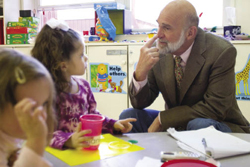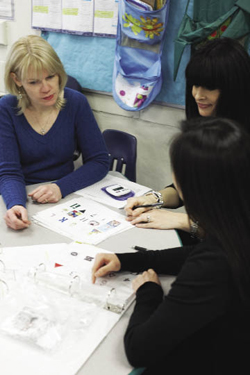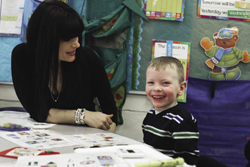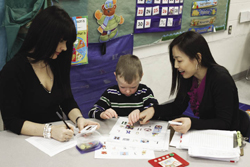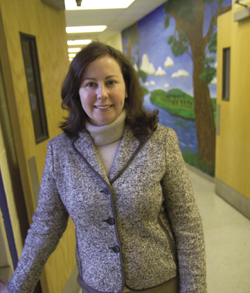Motivation Scientists
A behavioral approach to helping children learn, from the gifted to those with language disorders
“I took him to the playground every day for the next three weeks,” Marsigliano recalls ruefully. “I never heard
a word.”
Last spring, when John, a sweet-faced boy of five with wheat-colored hair, was placed in a special education class at the LINK Elementary School in Clarkstown, New York, he still wasn’t making eye contact or responding to voices. He often flapped his hands or made repetitive sounds—a kind of white-noise behavior called stereotypy.
Soon, though, things began to change. John’s teacher, Jackie Lewis, and assistant teacher, Helena Han, successfully engaged his attention with colorful pictures of animals and fairy-tale scenes, while offering a constant stream of praise (“Good job, buddy! Awesome! I’m so proud of you!”) Then they began alternating the pictures every 10 seconds with images of letters and numbers. One morning this past December, John scanned different letters and numbers for five minutes, matched them with cut-outs and pointed to them when asked. No hand-flapping, no noises. Afterward, Han gave him a high-five and a bunch of colored tokens, which he could redeem for time with a picture book. Then she graphed his progress on a chart and also her own performance in working with him.
Americans tend to think of teaching as an art, and of teachers as either born inspirers—Robin Williams in Dead Poets Society, coaxing a reticent student—or clueless drones, like Cheech and Chong’s Sister Mary Elephant (“Class… class…. Shut up, class!”).
But there is a different view, rooted in the American pragmatism of Charles Peirce and William James.
“When teaching is treated as an art, good teaching is an accident,” writes R. Douglas Greer in Designing Teaching Strategies: An Applied Behavior Analysis Systems Approach (Elsevier, 2002). “When teaching is treated as a science, good teaching can be replicated across many professionals in a reliable fashion.”
Greer, Professor of Psychology and Education at TC and director of the program that has produced Jackie Lewis, Helena Han and legions of other special education teachers, has created a teaching system based on the ideas of his own late mentor, the behavioral psychologist B.F. Skinner. The guiding precept is that human beings learn to do things (or not do them) in response to “reinforcers”—food, encouragement and other stimuli.
Language, which Greer believes is “how humans do the world,” is no exception. As he describes it, a baby comes out of the womb already familiar with the sound of her mother’s voice. While she nurses, she looks up at her mother’s face, and her mother coos at her. Face and voice become reinforced by food, laying the ground for the child to respond to other faces and voices. She imitates sounds her mother makes and discovers that doing so wins her more attention. Making sounds is reinforced by attention. She discovers that certain sounds elicit particular responses. And on it goes—a massive game of bait and switch, in which increasingly sophisticated language behaviors develop because they are reinforced by other events.
“Approval itself is a learned reinforcer,” Greer said in December, tilting back in a chair in his office in TC’s Thorndike Hall. Tall and lean at 68, with a trace of Tennessee drawl, he still runs marathons. “If I say, ‘Nice work’—unless you’ve had a history of conditioning for that to be a reinforcer—it’s not going to make you try to do a better job. So we start kids with edibles or tickles. Then we move to, say, tokens that can be exchanged for edibles, and we pair those tokens with approval and praise, so that kids will pay attention and you can actually instruct them.”
Greer did not invent this approach—which is called applied behavior analysis—but he has pioneered its application for educating children. His theories come from practice, rather than the other way around. Through more than 40 years of observing children in classrooms and residential facilities, he has identified key “cusps,” or stages of pre-verbal development that children progress through on the way to becoming fully verbal, interactive human beings. The ability to imitate actions (“see-do”) is a cusp; the ability to actually learn by observing others is another. Attainment of each cusp opens up new possibilities for learning.
Working at schools he founded in Yonkers, Westchester, England and Ireland, as well as at public schools in Rockland County and Morristown, New Jersey, Greer and his students have created scores of reinforcement-based interventions, or “protocols,” to induce children with language deficits to reach cusps. One example is rapid motor imitation, a Simon Says-like series of gestures, ending in the echoing of a sound or word, with which Greer has induced autistic children to speak their first words. Another is the “yoked contingency” game board, in which two students can move their pieces forward only when they learn to perform a task or solve a problem by watching each other.
All of these strategies are part of Greer’s method, which he calls CABAS (for Comprehensive Application of Behavior Analysis to Schooling). CABAS—which is trademarked, not for profit-making purposes, but to ensure that those working under its banner are fully proficient in its use—is constantly being revised and expanded by Greer’s students.
“Other centers that work with kids with autism don’t have exposure to the research base that we have,” says Alison Corwin, who is completing her Ph.D. this spring. “Our ideas are always evolving because the practitioners are the students.” Corwin calls it “an environment of constant learning” about what motivates children of all kinds to learn under all kinds of conditions.
From the get-go, master’s degree candidates in Greer’s program work in classrooms full-time under the supervision of his current or former Ph.D. students, adapting existing protocols or developing new ones to meet children’s needs. For example, Jackie Lewis, who is working on her Ph.D., and Helena Han, a second year master’s student, intend to publish a paper on how children develop the ability to match two-dimensional stimuli to printed targets. The paper confirms that the protocol they used with John Marsigliano will help students to attend to table-top stimuli and thus meet learning objectives at a faster rate—and also that two-dimensional print stimuli can be used as conditioned reinforcement for the much broader behavior of observing responses.
Above all, Greer’s students learn to read and apply research literature and use graphs and research findings to understand children’s progress and determine the differentiated instruction that works for each kid. (Greer likes to boast that the CABAS schools generate 3.2 million data points per month, and that children taught through the system learn at four to seven times the rate of their peers.) These skills also serve administrators who have graduated from the program. For example, the decision to put John in Jackie Lewis’s classroom was overseen by Yasmin Helou-Caré, a TC alumna who is in charge of special education placements for the district-based programs in the Rockland County BOCES school system. She, Lewis and Han all worked off the CABAS pyramid chart that showed the cusps John had attained, beginning with conditioning for faces and voices.
To Maureen Marsigliano, the idea of employing a behavioral approach with children was, at first, confusing. “It’s not how children are usually taught, at least judging by our experience with John’s older brother, who is typically developing,” she says. “I had people saying, be wary of that, the child might only do the instruction with the teacher.
I was concerned about that.”
Her reaction is a common one.
“When I first started, almost everyone would come into my classrooms with an anti-behavioral stance—‘this is bad, this is aversive punishment,’” says Greer, a former musician whose early studies demonstrated that children were more likely to prefer listening to classical music if they were praised for doing so. “Of course, they changed their tune when we made them count the number of approvals and disapprovals they expressed during their teaching, with the goal of eliminating the disapprovals.”
But the more important point, Greer and his acolytes argue, is that their methods are all about personalized teaching.
“Everyone likes to talk about ‘child-centered,’ but the only way to do that is to measure every response of the kid and how well the teacher is doing every day,” Greer says. “We do moment-to-moment, curriculum-based instruction, based on scientific measurement, and that lets us provide differentiated instruction, for kids of all abilities.”
The ultimate goal of Greer’s methods is to enable kids to make choices, adapt to situations, improvise and think creatively. In special education classrooms, that can mean something as basic as learning to play without prompting from an adult. For kids in mainstream classrooms in Morristown, New Jersey, it includes working at their own pace and tracking their own progress. Regardless, the essence of the approach is to make what is learned “generalizable.” Thus a CABAS teacher working on letter recognition will show students A’s in different colors, sizes and type-faces so that they come to understand “A” as something broader than any single representation.
Greer believes that the ability to acquire language comes to full flower when children attain the most important cusp of all: Naming—the ability to acquire new vocabulary without being directly instructed on the meaning of each word, but instead simply by hearing others use language. In typically developing children, Naming occurs somewhere around age three, and it results in an explosion of language acquisition that takes a child from just a few words to many, many thousands in a very short space of time—and ultimately, to the more than 86,000 words deemed necessary for success in school. Before Naming, Greer says, children are in the state described in Marquez’s One Hundred Years of Solitude, when “the world was so new that there were no names for many things, so all the people could do was point.” After Naming, the possibilities for growth and understanding are limitless.
For her part, Maureen Marsigliano will settle for more incremental progress for her son, John—at least for now.
“It’s slow, but he’s following verbal direction more from me, his dad and his brother—we don’t have to say things ten times anymore,” she says. “There’s a spark there that wasn’t there before. Jackie and Helena and Yasmin have a window into John’s mind that I don’t have. And they love him like their own kids—he comes home smelling of perfume every day, and when he gets on the bus in the morning, he’s smiling and not looking back. As a mother, that’s what you want.”
To see the CABAS method in action, visit www.tc.edu/news/7881.
Published Wednesday, Feb. 23, 2011
